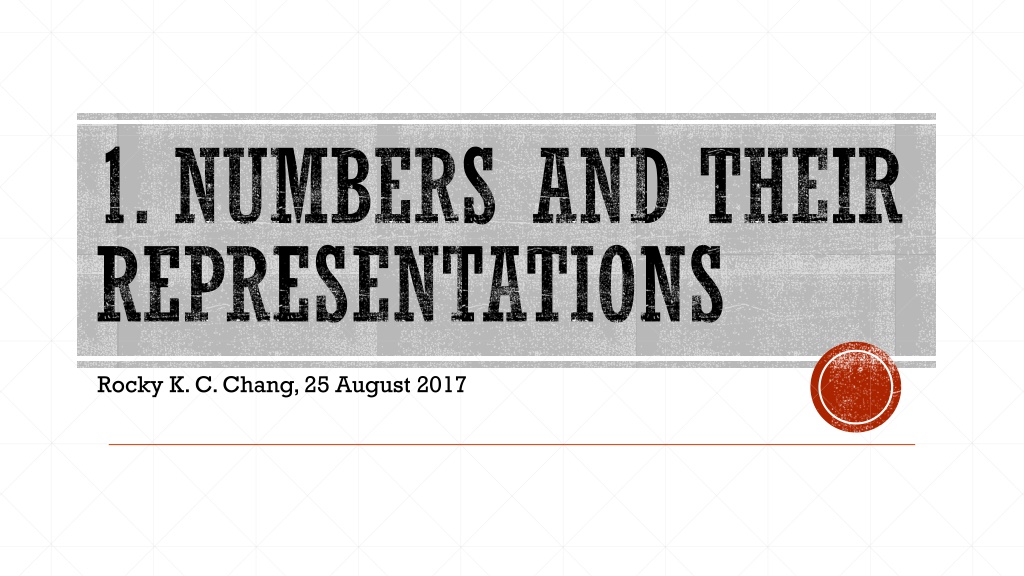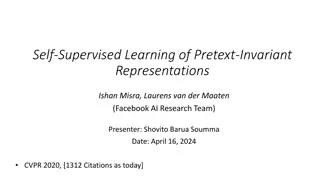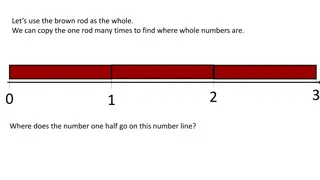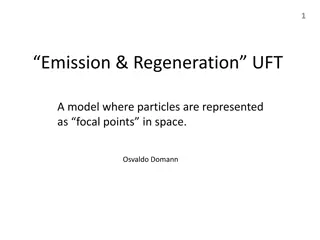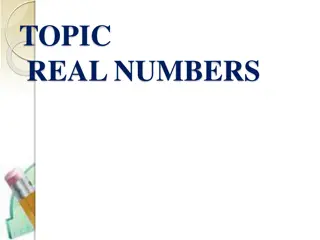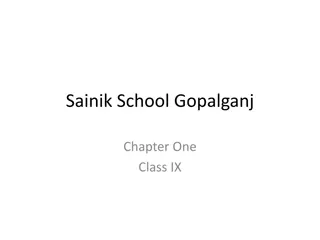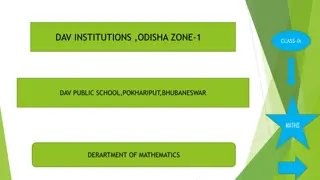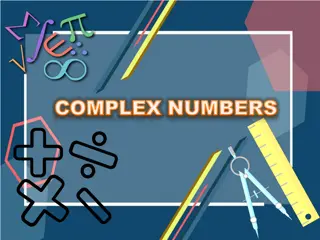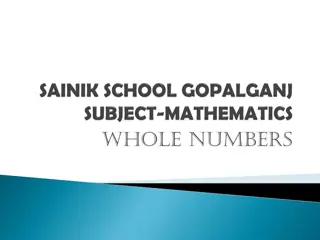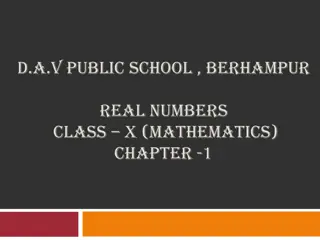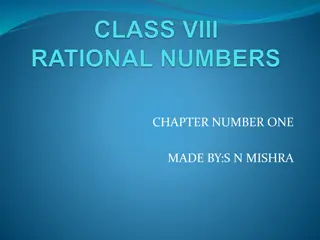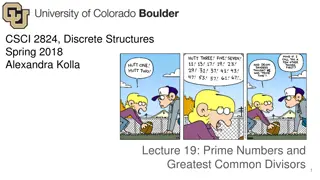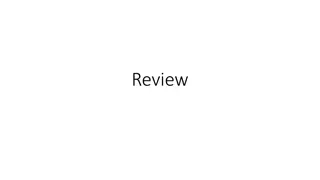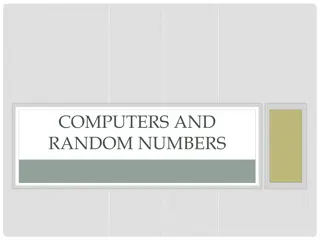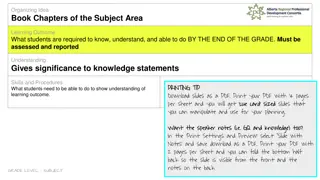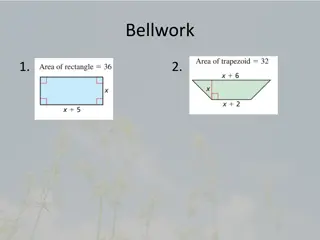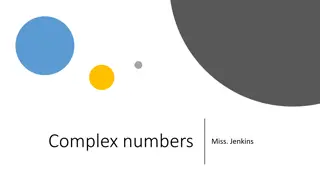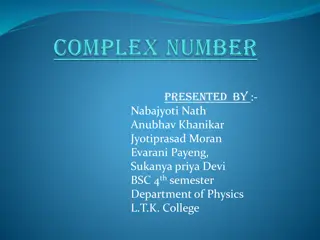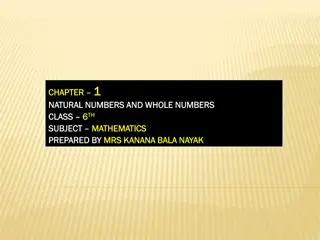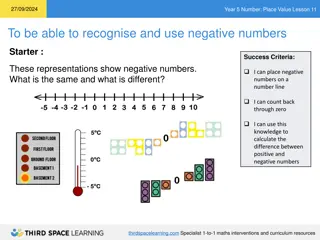Numbers and Their Representations
This lecture covers various number systems including binary, decimal, and hexadecimal, along with how to convert numbers from one base to another. It explains how integers and real numbers are represented in computers, including signed and unsigned integers, and 32/64-bit representations for real numbers.
Download Presentation

Please find below an Image/Link to download the presentation.
The content on the website is provided AS IS for your information and personal use only. It may not be sold, licensed, or shared on other websites without obtaining consent from the author.If you encounter any issues during the download, it is possible that the publisher has removed the file from their server.
You are allowed to download the files provided on this website for personal or commercial use, subject to the condition that they are used lawfully. All files are the property of their respective owners.
The content on the website is provided AS IS for your information and personal use only. It may not be sold, licensed, or shared on other websites without obtaining consent from the author.
E N D
Presentation Transcript
1. NUMBERS AND THEIR REPRESENTATIONS Rocky K. C. Chang, 25 August 2017
GOALS OF THIS LECTURE Review the number systems. Understand the class of positional number systems with different radix/base, such as binary, decimal, and hexadecimal. Know how to convert a number of a given base to its representation under another base. Understand how integers and real numbers are represented in computers. Understand how signed and unsigned integers are represented by a computer word. Understand how real numbers are represented by 32/64-bit computer words. 2
INSIDE COMPUTER, EVERYTHING IS A NUMBER. 4
THE DECIMAL SYSTEM System based on decimal digits (0, 1, 2, 3, 4, 5, 6, 7, 8, 9) to represent numbers E.g., 83 means eight tens plus three: 83 = (8 10) + 3 1 E.g., 4728 means four thousands, seven hundreds, two tens, plus eight: 4728 = (4 1000) + (7 100) + (2 10) + 8 1 The decimal system is said to have a base, orradix, of 10. 83 = (8 101) + (3 100) 4728 = (4 103) + (7 102) + (2 101) + (8 100) 5
DECIMAL FRACTIONS The same principle holds for decimal fractions. E.g., decimal fraction 0.256 stands for 2 tenths plus 5 hundredths plus 6 thousandths: 0.256 = (2 10-1) + (5 10-2) + (6 10-3) Therefore, the integer and fractional part can be expressed in terms of the base and the digit s position, e.g., 442.256 = (4 102) + (4 101) + (2 100) + (2 10-1) + (5 10-2) + (6 10-3) Most significant digit: The leftmost digit (carries the highest value) Least significant digit: The rightmost digit 6
TO SUMMARIZE FOR DECIMAL NUMBERS For a decimal number X = . . . d3d2d1d0.d-1d-2d-3 . . . , its value can be mathematically expressed as a summation: i = i X i d 10 7
POSITIONAL NUMBER SYSTEMS Each number is represented by a string of digits in which each digit position i has an associated weight ri, where r is the radix or base, of the number system. The general form of a number in such a system with radix r is ( . . . a3a2a1a0.a-1a-2a-3 . . . )r where the value of any digit aiis an integer in the range 0 < ai< r. The dot between a0and a-1 is called the radix point. The decimal system is just a particular case in this system. 8
POSITIONAL NUMBER SYSTEMS For r = 2 (binary), the possible values are 0 and 1. E.g., 101011.101101 For r= 8 (octal), the possible values are 0,1,2, ,7. E.g., 62512.036247, 101011.101101 For r = 16 (hexadecimal), the possible values are 0,1,2, ,9,A,B,C,D,E,F. E.g., 3048AE8.1320FF, 62512.036247, 101011.101101 We will use this notation---1100100two, 144oct, 100ten, 40hex----to distinguish them whenever necessary. 9
A NUMBERS DECIMAL VALUE With the weights of each digit position, we could similarly compute the decimal value of a number of any radix. For a number X = (. . . a3a2a1a0.a-1a-2a-3 . . . )r of radix r, its decimal value can be mathematically expressed as a summation: i i = X ( a ten ) ten r i 10110two = 1 2ten4 + 0 2ten3 + 1 2ten2 + 1 2ten1 + 0 2ten0 = 16ten + 4ten + 2ten = 22ten (A1)hex = 10ten 16ten1 + 1 16ten0 = 160ten + 1 = 161ten 10
THE SAME NUMBER IN DIFFERENT FORMS Using base 10 as a reference, a base < 10 is like expanding the number and a base > 10 is like contracting the number. Expanding: using more positions (because of a smaller set of values) Contracting: using less positions (because of a larger set of values) Say X = 100ten X can also be expressed as 1100100two 144oct 64hex 11
REVIEW QUESTIONS What is the range of values that a 4-bit decimal number can represent? What is the range of values that a 4-bit binary number can represent? What is the range of values that a 4-bit hexadecimal number can represent? 12
WHICH FORM IS THE BEST FOR COMPUTERS AND WHY? 13
THE BINARY SYSTEM ( . . . b3b2b1b0.b-1b-2b-3 . . . )2, where bi = 0,1 (binary digit, or bits) The digits 1 and 0 in binary notation have the same meaning as in decimal notation: 0two = 0ten 1two = 1ten For real number, 1001.101two = 2ten3 + 2ten0 + 2ten-1 + 2ten-3 = 9.625ten 14
DECIMAL INTEGER TO BINARY Repeated division-by-two method Example: 12ten 6 3 1 3 0 1 1 2 1 2 2 6 6 0 (a1) 2 2 2 2 1 (a2) 0 1 (a3) 0 (a0) This is the last step because the quotient is zero. 12ten = (a3 a2 a1 a0)two = (1100)two 15 Source: Prof. Qin Lu s slides
WHY THE REPEATED DIVISION-BY-TWO METHOD WORKS? Let Ntwo= (an-1an-2 a1a0)two Mten= an-1 2tenn-1 + an-2 2tenn-2+ + a1 2ten1+ a0 2ten0 Dividing Mtenby 2, we get Mten= 2 ten (an-1 2tenn-2 + an-2 2tenn-3+ + a1 2ten0) + a0 Quotient: an-1 2tenn-2+ an-2 2tenn-3+ + a1 2ten0 Reminder: a0 Repeating the last step for the quotient, we get a1 as the remainder. Keep doing that until the quotient is 0 to get (an-1an-2 a1a0)two. 16
DECIMAL INTEGER TO BINARY Convert the following numbers to their binary representation: 256ten 296ten 311ten 17
DECIMAL FRACTION TO BINARY Repeated multiply-by-two method Example, N = 0.45ten 0. 4 5 X 0. 9 0. 8 2 0. 6 2 0. 2 2 2 X X X X 2 0. 9(b-1 = 0) 1. 6(b-3 = 1) 1. 2(b-4 = 1) 0. 4(b-5 = 0) 1. 8(b-2 = 1) (0.45)ten = (b-1b-2b-3b-4b-5 )two = (0.01110 )two 18 Source: Prof. Qin Lu s slides
WHY THE REPEATED MULTIPLY-BY-TWO METHOD WORKS? Let Ntwo= (0.b-1b-2b-3 )two Mten= b-1 2ten-1 + b-2 2ten-2 + b-3 2ten-3 Multiplying Mtenby 2, we get Mten= b-1 +b-2 2ten-1 + b-3 2ten-2+ Repeating the last step for the fractional part and get b-2. Keep doing that to get (b-1b-2b-3 )two. 19
REVIEW QUESTIONS Visit http://www.geom.uiuc.edu/~huberty/math5337/groupe/digits.html for the value of Pi. Let just consider ten places after the radix point: 3.1415926535. Convert the fractional part to N-bit binary number, what is the accuracy of the binary representation for N = 5 N = 10 N = 15 20
HEXADECIMAL NOTATION Problem: How to read the bits in a more compact way? Binary digits are grouped into sets of four bits, called a nibble Each possible combination of four binary digits is given a symbol, as follows: 0000 = 0 0100 = 4 1000 = 8 0001 = 1 0101 = 5 1001 = 9 0010 = 2 0110 = 6 1010 = A 0011 = 3 0111 = 7 1011 = B 1100 = C 1101 = D 1110 = E 1111 = F When used for integers, e.g., 2Chex = (2hex 16ten1) + (Chex 16ten0) = (2ten 16ten1) + (12ten 16ten0) = 44ten 21
REPRESENTATION OF INTEGERS IN COMPUTERS 22
INTEGERS 23
SIGNED AND UNSIGNED INTEGERS C, C++, and Java have signed integers, e.g., 7, -255, e.g., int x, y, z; C, C++ also have unsigned integers, which are used for addresses, e.g., unsigned int x, y, z; 32-bit word can represent 232 binary numbers. Unsigned integers in 32-bit word represent 0 to 232-1 (4,294,967,295). 24
UNSIGNED INTEGERS 0000 0000 0000 0000 0000 0000 0000 0000two = 0ten 0000 0000 0000 0000 0000 0000 0000 0001two = 1ten 0000 0000 0000 0000 0000 0000 0000 0010two = 2ten ... 0111 1111 1111 1111 1111 1111 1111 1101two = 2,147,483,645ten 0111 1111 1111 1111 1111 1111 1111 1110two = 2,147,483,646ten 0111 1111 1111 1111 1111 1111 1111 1111two = 2,147,483,647ten 1000 0000 0000 0000 0000 0000 0000 0000two = 2,147,483,648ten 1000 0000 0000 0000 0000 0000 0000 0001two = 2,147,483,649ten 1000 0000 0000 0000 0000 0000 0000 0010two = 2,147,483,650ten ... 1111 1111 1111 1111 1111 1111 1111 1101two = 4,294,967,293ten 1111 1111 1111 1111 1111 1111 1111 1110two = 4,294,967,294ten 1111 1111 1111 1111 1111 1111 1111 1111two = 4,294,967,295ten ... ... 25
SIGNED INTEGERS Problem: how to represent negative numbers? We may want numbers <0, numbers >0, and one 0. Is it possible? Sign (1 bit) and magnitude (e.g., 0 101 for +5 and 1 101 for -5) Two zeros May need an extra step to set the sign bit Where to put the sign bit? 26
ONES COMPLEMENT The positive number is represented the same way before. Let X be a positive number and X is bitwise complement of X. Problems: Two zeros Need an extra step to subtract a number. + 0000 0001 0010 0011 0100 0101 0110 0111 - 1111 1110 1101 1100 1011 1010 1001 1000 0 1 2 3 4 5 6 7 27
TWOS COMPLEMENT The positive number is represented the same way before. The negative numbers are represented by the two's complement of their absolute value. The two's complement of an N-bit number is defined as the complement with respect to 2N. + 0000 0001 0010 0011 0100 0101 0110 0111 NA - NA 1111 1110 1101 1100 1011 1010 1001 1000 0 1 2 3 4 5 6 7 8 28
AN GEOMETRIC VIEW OF TWO S COMPLEMENT INTEGERS 29 Source: Stallings,Computer organization and architecture:Designing for performance, 9th edition, Prentice Hall, 2013.
TWOS COMPLEMENT Two s complement treats 0 as positive, so a 32-bit word represents 232 integers from -231 ( 2,147,483,648) to 231-1 (2,147,483,647) Note: one negative number with no positive version Every computer uses two s complement today The most-significant bit (MSB) indicates the sign, since positive numbers (including 0) always start with 0 and negative numbers 1. Bit 31 is the most significant; bit 0 is the least significant. Note that the MSB is not a sign bit. 30
TWOS-COMPLEMENT INTEGERS Sign Bit 0000 0000 0000 0000 0000 0000 0000 0000two = 0ten 0000 0000 0000 0000 0000 0000 0000 0001two = 1ten 0000 0000 0000 0000 0000 0000 0000 0010two = 2ten 0111 1111 1111 1111 1111 1111 1111 1101two = 2,147,483,645ten 0111 1111 1111 1111 1111 1111 1111 1110two = 2,147,483,646ten 0111 1111 1111 1111 1111 1111 1111 1111two = 2,147,483,647ten 1000 0000 0000 0000 0000 0000 0000 0000two = 2,147,483,648ten 1000 0000 0000 0000 0000 0000 0000 0001two = 2,147,483,647ten 1000 0000 0000 0000 0000 0000 0000 0010two = 2,147,483,646ten ... 1111 1111 1111 1111 1111 1111 1111 1101two = 3ten 1111 1111 1111 1111 1111 1111 1111 1110two = 2ten 1111 1111 1111 1111 1111 1111 1111 1111two = 1ten ... ... ... 31
MAKING TWOS COMPLEMENT For N-bit word, complement to 2tenN For 4-bit number 5ten=0101two, two s complement (i.e., -5ten) would be 16ten- 5ten=11ten or 10000two 0101two = 1011two A more straightforward approach Take the bitwise complement of N and then add 1 (1010two + 1two). N+ ones complement of N = 2tenN 1 (e.g., all 1s in binary) N+ two s complement of N = 2tenN Thus, two s complement of N = (ones complement of N)two + 1two. 32
REVIEW QUESTIONS For 8-bit word, What is the largest integer two s complement can represent? What is its hexadecimal value? What is the two s complement of this largest integer? What is the smallest integer two s complement can represent? What is its hexadecimal value? What is the two s complement of this smallest integer? 33
TWOS-COMPLEMENT EXAMPLES Assume for simplicity 4 bit width, -8 to +7 represented 0011 0010 0101 1101 1110 3 0011 1110 -3 3 +2 5 + (-2) -51 1011 + (-2) 1 1 0001 0111 0001 1000 7 1000 1111 -8 +1 -8 Overflow! + (-1) +71 0111 Overflow! Carry into MSB = Carry Out MSB Carry into MSB Carry Out MSB 34
CONVERTING TWOS-COMPLEMENT INTEGER TO DECIMAL For a n-digit number D in two s complement representation:(dn-1dn-2 d1d0)two, the number in decimal is given by n 2 = i n 1 i = + N d 2 d 2 n 1 ten i ten 0 When dn-1 = 0 (positive), the number is determined by the summation. When dn-1 = 1 (negative), the number is determined by -2n-1 plus the summation. 35
A SUMMARY FOR TWOS COMPLEMENT INTEGERS 36 Source: Stallings,Computer organization and architecture:Designing for performance, 9th edition, Prentice Hall, 2013.
REPRESENTATION OF REAL NUMBERS IN COMPUTER 37
REAL NUMBERS A real number is represented by IntegerPart (I) + RadixPoint + FractionalPart (F) Where to put the radix point? If it is fixed to a location, the range of data is very limited (not flexible). For example, there are a total of 8 bits for I and F. (I,F) could be (7,1), (6,2), (5,3) , (1,7). Each of this offers different ranges of numbers and precision for the fractional part. If (I,F) = (4,4) No problem for 0110.0000 + 0000.0110 But what about 0.0000001 and 1000001.1? 38
FLOATING POINT Idea: Let the radix point floating according to the number. Write a real number in scientific notation: S x B E. S: significand (also called mantissa including the sign bit) B: base E: exponent E.g., 9896.54ten = 9.89654ten x 10ten3 (or 9.89654E3ten) E.g., 1110.01two = 1.11001two X 23 (or 1.11001E3two) 39
NORMALIZING THE SIGNIFICAND Given a real number, there are an infinitely number of ways to express it using the scientific notation. E.g., 11001.0 can be expressed as , 1100100.E-2, 110010.E-1, 11001.0E0, 1100.1E1, 110.01E2, . A positive (negative) exponent moves the radix point to the right (left) by the absolute value of the exponent. Need a standard format to simplify the design. Normalized significand: 1.xxxxxxxtwo 2yyyy No need to store the MSB Need to store the sign bit and the bits after the radix point Note that 0 cannot be represented. Therefore, we will use 1.1001E4 for the example above. 40
FLOATING POINT STANDARD Defined by IEEE Std 754-1985 Developed in response to divergence of representations Portability issues for scientific code Now almost universally adopted How to strike the right balance between range and precision? Two representations Single precision (32-bit) Double precision (64-bit)
IEEE FLOATING-POINT FORMAT single: 8 bits double: 11 bits single: 23 bits double: 52 bits S Exponent Fraction Bias) = + S (Exponent x ( 1) (1 Fraction) 2 S: sign bit (0 => non-negative, 1 => negative) Sign and magnitude Normalize significand: 1.0 |significand| < 2.0 Always has a leading pre-binary-point 1 bit, so no need to represent it explicitly (hidden bit) Significand is Fraction with the 1. restored. 42
IEEE FLOATING-POINT FORMAT (CONTD) The exponent could be negative, 0, or positive. How to represent it? Two s complement is not easy to compare. Use one that preserves the original order (0000 < 0001 < 0010 < ). Using a bias (Single: bias = 127; Double: bias = 1203) The Exponent is an unsigned number. The actual exponent value is Exponent subtracted by the bias. For single-precision, the range of exponent value is between -127 (0 127) and 128 (255 127). 43
IEEE FLOATING-POINT FORMAT (CONTD) By labelling the 32 bits in the single-precision by (b31b30 b1b0)two, the binary representation of a floating-point number is 127 b ( b b ... b ) ) = ) 1 . 1 ( X ( b b ... b ) 2 31 30 29 23 two two 22 21 0 two Its decimal value is given by 23 127 b = ) 1 1 ( + i ( e ) X ( b 2 ) 2 31 ten 23 i = i 1 where = 7 = i e 232 b + i i 0 44
FLOATING-POINT EXAMPLE Represent 0.75 0.75 = ( 1)1 1.1two 2 1 S = 1 Fraction = 1000 00two Exponent = 1 + bias Single: 1 + 127 = 126 = 01111110two Double: 1 + 1023 = 1022 = 01111111110two Single: 1011111101000 00 Double: 1011111111101000 00 Chapter 3 Arithmetic for Computers 45
FLOATING-POINT EXAMPLE What number is represented by the single-precision float 11000000101000 00? S = 1 Fraction = 01000 00two Exponent = 10000001two = 129 x = ( 1)1 (1 + .01two) 2(129 127) = ( 1) 1.25 22 = 5.0 Chapter 3 Arithmetic for Computers 46
REVIEW QUESTIONS What is the real number represented by the single-precision float below? 00111110001000000000000000000000 What is the single-precision float of 111.111ten? 47
SINGLE-PRECISION RANGE Exponents 00000000 and 11111111 reserved Smallest value Exponent: 00000001 actual exponent = 1 127 = 126 Fraction: 000 00 significand = 1.0 1.0 2 126 1.2 10 38 Largest value exponent: 11111110 actual exponent = 254 127 = +127 Fraction: 111 11 significand 2.0 2.0 2+127 3.4 10+38
DOUBLE-PRECISION RANGE Exponents 0000 00 and 1111 11 reserved Smallest value Exponent: 00000000001 actual exponent = 1 1023 = 1022 Fraction: 000 00 significand = 1.0 1.0 2 1022 2.2 10 308 Largest value Exponent: 11111111110 actual exponent = 2046 1023 = +1023 Fraction: 111 11 significand 2.0 2.0 2+1023 1.8 10+308
EXPRESSIBLE NUMBERS 50 Source: Stallings,Computer organization and architecture:Designing for performance, 9th edition, Prentice Hall, 2013.
